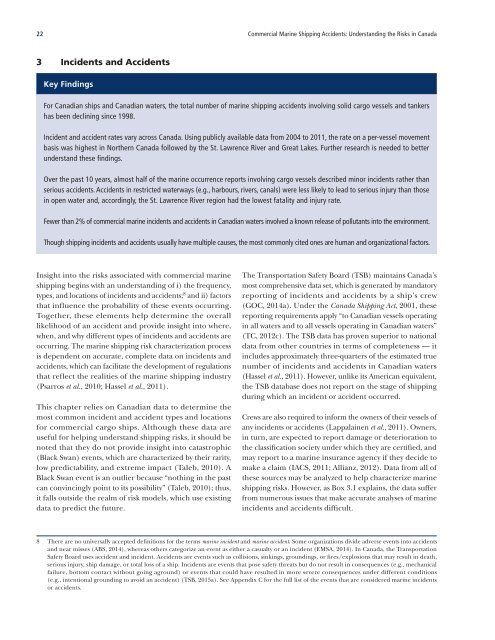Commercial Marine Shipping Accidents Understanding Risks Canada
cca_marine_shipping_risks_en_fullreport
cca_marine_shipping_risks_en_fullreport
Create successful ePaper yourself
Turn your PDF publications into a flip-book with our unique Google optimized e-Paper software.
22 <strong>Commercial</strong> <strong>Marine</strong> <strong>Shipping</strong> <strong>Accidents</strong>: <strong>Understanding</strong> the <strong>Risks</strong> in <strong>Canada</strong><br />
3 Incidents and <strong>Accidents</strong><br />
Key Findings<br />
For Canadian ships and Canadian waters, the total number of marine shipping accidents involving solid cargo vessels and tankers<br />
has been declining since 1998.<br />
Incident and accident rates vary across <strong>Canada</strong>. Using publicly available data from 2004 to 2011, the rate on a per-vessel movement<br />
basis was highest in Northern <strong>Canada</strong> followed by the St. Lawrence River and Great Lakes. Further research is needed to better<br />
understand these findings.<br />
Over the past 10 years, almost half of the marine occurrence reports involving cargo vessels described minor incidents rather than<br />
serious accidents. <strong>Accidents</strong> in restricted waterways (e.g., harbours, rivers, canals) were less likely to lead to serious injury than those<br />
in open water and, accordingly, the St. Lawrence River region had the lowest fatality and injury rate.<br />
Fewer than 2% of commercial marine incidents and accidents in Canadian waters involved a known release of pollutants into the environment.<br />
Though shipping incidents and accidents usually have multiple causes, the most commonly cited ones are human and organizational factors.<br />
Insight into the risks associated with commercial marine<br />
shipping begins with an understanding of i) the frequency,<br />
types, and locations of incidents and accidents; 8 and ii) factors<br />
that influence the probability of these events occurring.<br />
Together, these elements help determine the overall<br />
likelihood of an accident and provide insight into where,<br />
when, and why different types of incidents and accidents are<br />
occurring. The marine shipping risk characterization process<br />
is dependent on accurate, complete data on incidents and<br />
accidents, which can facilitate the development of regulations<br />
that reflect the realities of the marine shipping industry<br />
(Psarros et al., 2010; Hassel et al., 2011).<br />
This chapter relies on Canadian data to determine the<br />
most common incident and accident types and locations<br />
for commercial cargo ships. Although these data are<br />
useful for helping understand shipping risks, it should be<br />
noted that they do not provide insight into catastrophic<br />
(Black Swan) events, which are characterized by their rarity,<br />
low predictability, and extreme impact (Taleb, 2010). A<br />
Black Swan event is an outlier because “nothing in the past<br />
can convincingly point to its possibility” (Taleb, 2010); thus,<br />
it falls outside the realm of risk models, which use existing<br />
data to predict the future.<br />
The Transportation Safety Board (TSB) maintains <strong>Canada</strong>’s<br />
most comprehensive data set, which is generated by mandatory<br />
reporting of incidents and accidents by a ship’s crew<br />
(GOC, 2014a). Under the <strong>Canada</strong> <strong>Shipping</strong> Act, 2001, these<br />
reporting requirements apply “to Canadian vessels operating<br />
in all waters and to all vessels operating in Canadian waters”<br />
(TC, 2012c). The TSB data has proven superior to national<br />
data from other countries in terms of completeness — it<br />
includes approximately three-quarters of the estimated true<br />
number of incidents and accidents in Canadian waters<br />
(Hassel et al., 2011). However, unlike its American equivalent,<br />
the TSB database does not report on the stage of shipping<br />
during which an incident or accident occurred.<br />
Crews are also required to inform the owners of their vessels of<br />
any incidents or accidents (Lappalainen et al., 2011). Owners,<br />
in turn, are expected to report damage or deterioration to<br />
the classification society under which they are certified, and<br />
may report to a marine insurance agency if they decide to<br />
make a claim (IACS, 2011; Allianz, 2012). Data from all of<br />
these sources may be analyzed to help characterize marine<br />
shipping risks. However, as Box 3.1 explains, the data suffer<br />
from numerous issues that make accurate analyses of marine<br />
incidents and accidents difficult.<br />
8 There are no universally accepted definitions for the terms marine incident and marine accident. Some organizations divide adverse events into accidents<br />
and near misses (ABS, 2014), whereas others categorize an event as either a casualty or an incident (EMSA, 2014). In <strong>Canada</strong>, the Transportation<br />
Safety Board uses accident and incident. <strong>Accidents</strong> are events such as collisions, sinkings, groundings, or fires/explosions that may result in death,<br />
serious injury, ship damage, or total loss of a ship. Incidents are events that pose safety threats but do not result in consequences (e.g., mechanical<br />
failure, bottom contact without going aground) or events that could have resulted in more severe consequences under different conditions<br />
(e.g., intentional grounding to avoid an accident) (TSB, 2015a). See Appendix C for the full list of the events that are considered marine incidents<br />
or accidents.


